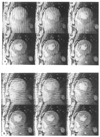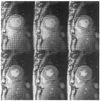Cardiac tagging with breath-hold cine MRI
- PMID: 1461130
- PMCID: PMC2041925
- DOI: 10.1002/mrm.1910280214
Cardiac tagging with breath-hold cine MRI
Abstract
A method is presented for measuring myocardial deformation in a breath-hold with tagged cine MRI. Tagged cine images of human hearts are obtained in arbitrary oblique planes on a standard imager with as few as four heartbeats. The scan time has been reduced 16- to 64-fold from previous techniques.
Figures







References
Publication types
MeSH terms
Grants and funding
LinkOut - more resources
Full Text Sources
Other Literature Sources
Medical

